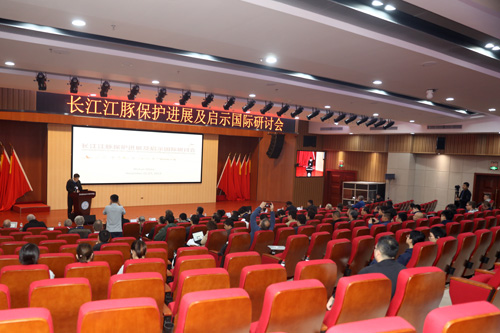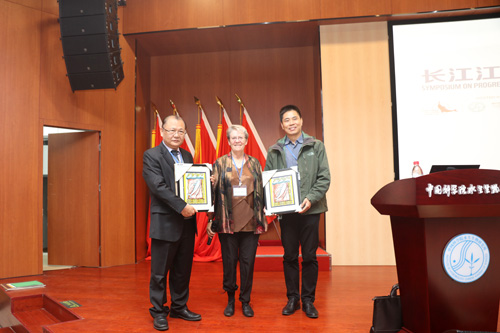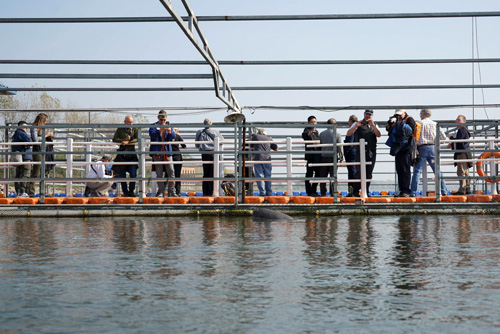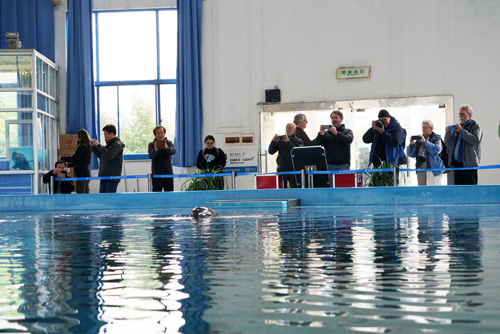
International
Symposium on Progress of Yangtze Finless Porpoise Conservation and Outlook for Other Endangered Small Cetaceans


The Symposium on Progress of Yangtze Finless Porpoise Conservation and Outlook for Other Endangered Small Cetaceans was held at IHB during November 24 and 26, 2019.
The Symposium on Progress of Yangtze Finless Porpoise Conservation and Outlook for Other Endangered Small Cetaceans was held at Institute of Hydrobiology (IHB) of Chinese Academy of Sciences during November 24 and 26, 2019. More than 80 experts of cetacean from the U.S., U.K., New Zealand, the Netherlands, Italy, and Australia attended the symposium.
ZHAO Yimin, deputy director of the Yangtze River Fishing Supervision and Administration Office under the Ministry of Agriculture, said that we shall not lose the cherished Yangtze finless porpoises since so many aquatic animals in the Yangtze died out. “What we do today is to prevent the Yangtze finless porpoises from going the same way as the Baiji dolphin.”
"It is crucial to rehabilitate the Yangtze River," said WU Minglu from the State Forestry and Grassland Administration. China is now enacting the protection law of the Yangtze River and a 10-year fishing ban is about to be implemented. “The State Forestry and Grassland Administration will strengthen the construction of the Yangtze finless reserves and enhance its management ability. We hope more feasible ways can be applied to different reserves to let the porpoises get off the endangered status.”
In the three-day meeting, representatives listened to presentations on the ex-situ conservation and artificial breeding of the porpoises and discussed on the challenges and threats that the porpoises are still facing. Topics centered on how to determine the number and the population size of the ex-situ porpoises, how to effectively carry out genetic management of ex-situ conservation population and thus reduce the risk of infectious diseases, how to effectively quantify the risks and threats to nature conservation populations.
The natural release strategies, steps and techniques of ex-situ conservation population were also discussed at the meeting. Through model prediction and discussion, the short-term, medium-term and long-term conservation goals of finless porpoises in the Yangtze River were summarized.
During the symposium a small press conference was held where Dr. Barbara Taylor from the National Oceanic and Atmospheric Administration and Prof. WANG Ding from IHB introduced the main topics and significance the symposium to the media.
Prof. Wang said that China has achieved a lot in the ex-situ conservation and artificial breeding of the porpoises. “The rapid decrease of the porpoise population has been restraint, but the extremely endangered condition has changed. There’s still a long way to go. This symposium served as a platform to further optimize the protection strategy of finless porpoises in the Yangtze River.”
Dr. Barbara Taylor said that China has made inspiring achievements in the protection of finless porpoises in the Yangtze River. China has put in place a comprehensive strategy to protect the finless porpoises in the Yangtze River, forming a complete protection system led by the government and industry departments, supported by scientific research institutions and involved by the nationals. “What have been done in China can be learned by other countries to save other endangered small-scale cetaceans.” said Taylor.


Dr. Barbara Taylor from the National Oceanic and Atmospheric Administration presented two pictures of Yangtze finless porpoises drawn by her to Prof. WANG Ding and Dr. HAO Yujiang.


Attendees had a field trip to nature reserve of Yangtze finless porpoises.


Attendees visited the Baiji Dolphinarium.


Prof. WANG Ding introduced the conservation status of Yangtze finless porpoises to the attendees.